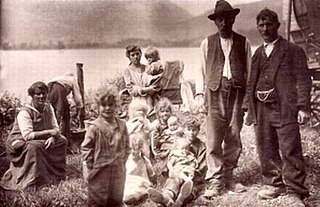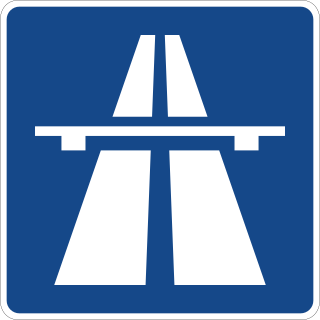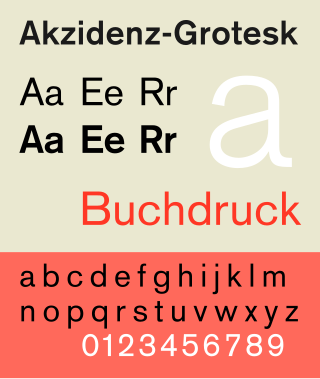
The national flag of Germany is a tricolour consisting of three equal horizontal bands displaying the national colours of Germany: black, red, and gold. The flag was first sighted in 1848 in the German Confederation. It was officially adopted as the national flag of the German Reich from 1919 to 1933, and has been in use since its reintroduction in Federal Republic of Germany in 1949.

In German orthography, the letter ß (lowercase), called Eszett and scharfes S, represents the phoneme in Standard German when following long vowels and diphthongs. The letter-name Eszett combines the names of the letters of ⟨s⟩ and ⟨z⟩ in German. The character's Unicode names in English are sharp s and eszett. The Eszett letter is used only in German, and can be typographically replaced with the double-s digraph ⟨ss⟩, if the ß-character is unavailable. In the 20th century, the ß-character was replaced with ss in the spelling of Swiss Standard German, while remaining Standard German spelling in other varieties of the German language.

The Austrian Empire, officially known as the Empire of Austria, was a multinational European great power from 1804 to 1867, created by proclamation out of the realms of the Habsburgs. During its existence, it was the third most populous monarchy in Europe after the Russian Empire and the United Kingdom. Along with Prussia, it was one of the two major powers of the German Confederation. Geographically, it was the third-largest empire in Europe after the Russian Empire and the First French Empire.

The coat of arms of Germany displays a black eagle with a red beak, a red tongue and red feet on a golden field, which is blazoned: Or, an eagle displayed sable beaked langued and membered gules. This is the Bundesadler, formerly known as Reichsadler. It is one of the oldest coats of arms in the world, and today the oldest national symbol used in Europe.

The Yenish are an itinerant group in Western Europe who live mostly in Germany, Austria, Switzerland, Luxembourg, Belgium, and parts of France, roughly centred on the Rhineland. A number of theories for the group's origins have been proposed, including that the Yenish descended from members of the marginalized and vagrant poor classes of society of the early modern period, before emerging as a distinct group by the early 19th century. Most of the Yenish became sedentary in the course of the mid-19th to 20th centuries.

The German word Schwabacher refers to a specific style of blackletter typefaces which evolved from Gothic Textualis (Textura) under the influence of Humanist type design in Italy during the 15th century. Schwabacher typesetting was the most common typeface in Germany, until it was replaced by Fraktur from the mid 16th century onwards.

The Autobahn is the federal controlled-access highway system in Germany. The official German term is Bundesautobahn, which translates as 'federal motorway'. The literal meaning of the word Bundesautobahn is 'Federal Auto(mobile) Track'.

A district is a second-level division of the executive arm of the Austrian government. District offices are the primary point of contact between residents and the state for most acts of government that exceed municipal purview: marriage licenses, driver licenses, passports, assembly permits, hunting permits, or dealings with public health officers for example all involve interaction with the district administrative authority.

Clearview, also known as Clearview Hwy, is the name of a humanist sans-serif typeface family for guide signs used on roads in the United States, Canada, Indonesia, the Philippines, Israel, Brazil and Sri Lanka. It was developed by independent researchers with the help of the Texas Transportation Institute and the Pennsylvania Transportation Institute, under the supervision of the Federal Highway Administration (FHWA). It was once expected to replace the FHWA typefaces in many applications, although newer studies of its effectiveness have called its benefits into question.

Akzidenz-Grotesk is a sans-serif typeface family originally released by the Berthold Type Foundry of Berlin. "Akzidenz" indicates its intended use as a typeface for commercial print runs such as publicity, tickets and forms, as opposed to fine printing, and "grotesque" was a standard name for sans-serif typefaces at the time.

DIN 1451 is a sans-serif typeface that is widely used for traffic, administrative and technical applications.

The FE-Schrift or Fälschungserschwerende Schrift is a sans serif typeface introduced for use on licence plates. Its monospaced letters and numbers are slightly disproportionate to prevent easy modification and to improve machine readability. It has been developed in Germany where it has been mandatory since November 2000.

Anti-Jewish legislation in pre-war Nazi Germany comprised several laws that segregated the Jews from German society and restricted Jewish people's political, legal and civil rights. Major legislative initiatives included a series of restrictive laws passed in 1933, the Nuremberg Laws of 1935, and a final wave of legislation preceding Germany's entry into World War II.

Implenia is a Swiss real estate and construction services company with activities in development and civil engineering in Switzerland and Germany. Implenia is also active in tunnelling and related infrastructure construction in Austria, France, Sweden, Norway and Italy. The Group was formed at the beginning of 2006 from the merger of Basel-based Batigroup Holding AG with Geneva-based Zschokke Holding SA. The headquarters are located in Glattpark (Opfikon) in the canton of Zurich. Implenia is one of the 500 largest companies in Switzerland.

European traffic signs present relevant differences between countries despite an apparent uniformity and standardisation. Most European countries refer to the 1968 Vienna Convention on Road Signs and Signals. The convention has been adopted by the following countries : Albania, Armenia, Austria, Belarus, Belgium, Bosnia and Herzegovina, Bulgaria, Croatia, Cyprus, the Czech Republic, Denmark, Estonia, Finland, France, Georgia, Germany, Greece, Hungary, Italy, Latvia, Liechtenstein, Lithuania, Luxembourg, Moldova, Montenegro, Netherlands, North Macedonia, Norway, Poland, Portugal, Romania, Russia, San Marino, Serbia, Slovakia, Slovenia, Spain, Sweden, Switzerland, Turkey, Ukraine and the United Kingdom. The convention has not been adopted by Ireland, Iceland or Malta.
Stefan Weber is an Austrian media researcher and writer. The mass media often call him "plagiarism hunter".
Engschrift is a condensed or "narrow" form of the DIN 1451 standard typeface. It is used in a modified form for road signage in Austria.
Emma Maria Wolffhardt was a German Industrial Chemist at BASF and she was the first women chemist at BASF who had her own research area. Furthermore, she was the first to use the calotte model for understanding and improving organic synthesis.
Sankt Stefan-Afiesl is a municipality in Rohrbach District of Upper Austria, Austria. As of 1 January 2019, population was 1100.














